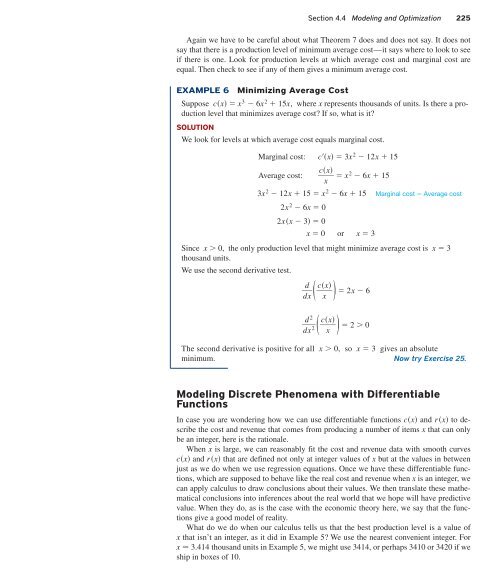5128_Ch04_pp186-260
Create successful ePaper yourself
Turn your PDF publications into a flip-book with our unique Google optimized e-Paper software.
Section 4.4 Modeling and Optimization 225<br />
Again we have to be careful about what Theorem 7 does and does not say. It does not<br />
say that there is a production level of minimum average cost—it says where to look to see<br />
if there is one. Look for production levels at which average cost and marginal cost are<br />
equal. Then check to see if any of them gives a minimum average cost.<br />
EXAMPLE 6 Minimizing Average Cost<br />
Suppose cx x 3 6x 2 15x, where x represents thousands of units. Is there a production<br />
level that minimizes average cost? If so, what is it?<br />
SOLUTION<br />
We look for levels at which average cost equals marginal cost.<br />
Marginal cost: cx 3x 2 12x 15<br />
Average cost: c x<br />
x<br />
x<br />
6x 15<br />
3x 2 12x 15 x 2 6x 15 Marginal cost Average cost<br />
2x 2 6x 0<br />
2xx 3 0<br />
x 0 or x 3<br />
Since x 0, the only production level that might minimize average cost is x 3<br />
thousand units.<br />
We use the second derivative test.<br />
d<br />
d<br />
( x<br />
x<br />
x<br />
) 2x 6<br />
d<br />
2<br />
d x2( x<br />
x<br />
) 2 0<br />
The second derivative is positive for all x 0, so x 3 gives an absolute<br />
minimum. Now try Exercise 25.<br />
Modeling Discrete Phenomena with Differentiable<br />
Functions<br />
In case you are wondering how we can use differentiable functions cx and rx to describe<br />
the cost and revenue that comes from producing a number of items x that can only<br />
be an integer, here is the rationale.<br />
When x is large, we can reasonably fit the cost and revenue data with smooth curves<br />
cx and rx that are defined not only at integer values of x but at the values in between<br />
just as we do when we use regression equations. Once we have these differentiable functions,<br />
which are supposed to behave like the real cost and revenue when x is an integer, we<br />
can apply calculus to draw conclusions about their values. We then translate these mathematical<br />
conclusions into inferences about the real world that we hope will have predictive<br />
value. When they do, as is the case with the economic theory here, we say that the functions<br />
give a good model of reality.<br />
What do we do when our calculus tells us that the best production level is a value of<br />
x that isn’t an integer, as it did in Example 5? We use the nearest convenient integer. For<br />
x 3.414 thousand units in Example 5, we might use 3414, or perhaps 3410 or 3420 if we<br />
ship in boxes of 10.












